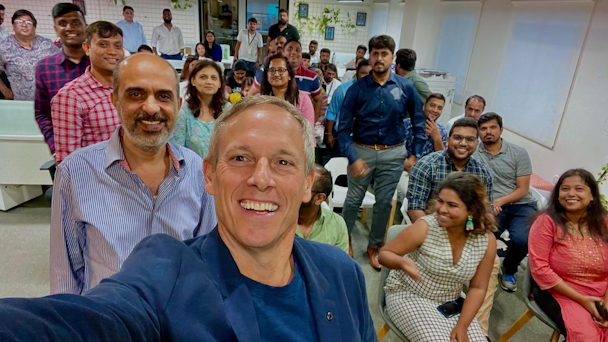How do you keep a client for nearly 90 years? Just ask GPJ
Experiential agency George P Johnson turned 110 years old earlier this summer. The Drum sat down with global chief executive Chris Meyer to hear the secrets behind some of marketing’s longest client relationships.

GPJ global chief executive Chris Meyer with the agency’s team in India / GPJ
Flag Day in the US, held on June 14th, honors the stars and the stripes, the US national flag. It’s also the day this year that experiential agency George P Johnson (GPJ) chose to celebrate its 110th birthday.
The flag connection was no accident, says the company’s global chief executive Chris Meyer. “GPJ started out making sails on the Great Lakes and then moved into bunting and then, during the wars, moved into making US flags,” he explains.
After flags and bunting – the most recognizable marketing feature of many parade floats and car showrooms – next came auto trade shows. Today, the company has a diverse portfolio of clients, operates in 18 countries, and has 1,500 employees.
“We still have seamstresses in our shops because we do a lot of large-scale graphics and fabrics that are used at large events, shows, and festivals. They’re just not making a lot of bunting.”
Relationship maintenance
Towards the end of the 1990s, Robert Vallee Jr., grandson of GPJ’s founder George P. Johnson, became the agency’s chief executive. The company also opened offices in San Jose, California, at this time and soon landed a contract with Cisco Systems.
Now, IBM is a 26-year contract, Salesforce 16 years, and Workday 12 years – all impressive clients in the B2B tech space. But the oldest relationship? Jeep, at 87 years – a partnership that began in 1937.
The secret to maintaining a relationship of that length, Meyer says, is based on the right mix of integrity and innovation – along with excellent client services.
“At a macro level, all of our relationships are based on the fact a lot of our clients don‘t know the difference between our team and their team. We become true partners. It’s less of a vendor-client relationship, and that‘s what that partnership is based on.
“It‘s based on trust, it‘s based on transparency, it‘s based on ethics. We‘re a very, very ethical company… And obviously, bring creativity and quality and team.”
He adds: “It comes down to having the innovation, creativity, the quality of service, but most importantly making sure that we have the right team that‘s building the depth and strength of relationships.”
Experience matters
The core of what GPJ does has always been experiential. “When you talk about some of the tenures that we have with these clients,” Meyer explains. “The clients that we have mostly understand the power of experiential.”
Scott Kellner, senior vice president of sales and marketing at GPJ, explains what experiential means to the agency. “Experiential is the only form of marketing that isn‘t creepy or interruptive,” he says.
“Everything in the marketing and communications world requires you to stop what you want to be doing and do what the advertiser wants you to do. At best, that is tolerated – slightly irritating and tolerated. This moves down the scale to creepy when you start looking at retargeting and that sort of thing.”
“We‘re extremely proud of the fact that we are a voluntary form of marketing, where people self-identify as being brand ambassadors who want to participate with the brand, really narrowing the funnel.
“It is an extremely powerful complement to highly leveraged and measured digital marketing. If you combine the anthropological elements of experiential, with all the data you have from digital, you start to have a much more holistic picture of who your buyer is.”
Another 110 years?
Meyer says experiential marketers are finally receiving the credit they deserve, allowed a seat at the ‘adult’s table,’ with the work recognized as above-the-line.
“When you look at brand spend, experiential is often the largest piece of the puzzle. That plays out even in how we are engaged; we‘re now engaged at a more strategic level, meaning that we have grown our strategy and planning practice.
“So we‘re now involved earlier on in the cycle, helping clients look at what tactics are they going to use. What does their experiential event portfolio look like? How does that integrate with other marketing tactics?”
A real draw for clients to hold events is that they can use them to produce content for social media, digital advertising, and other platforms. “The metaphor has changed from this is a one-time event to this is a studio where we‘re creating real content,” Meyer explains.
So will GPJ be around in another 110 years from now? “We truly believe that experiential will continue to be at the core of marketing for brands. For us, I think the future will be just like the past. It‘s about finding brands that believe in experiential and helping them expand and grow their business through experiences, whether that takes us into different verticals, or whether it takes into different geographies.”
Content created with:

George P. Johnson
For over a century, George P. Johnson’s driving passion is helping clients foster innovation, value, growth and increased performance through the creative evolution...
